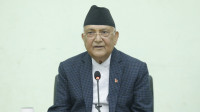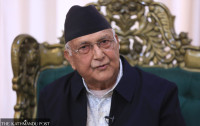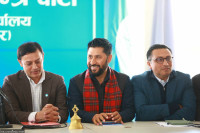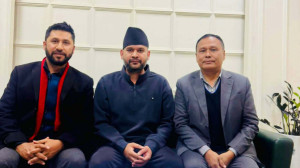Politics
Where the Janata Samajbadi Party is when ruling and opposition parties are failing
At a time when the federal system is under attack, party leaders admit that they are disoriented, largely because they are trying to figure out their goal, purpose and ideology.
Anil Giri
One month short of 14 years ago, Nepal’s Madhes region was burning. Protests flared up across the Tarai plains and continued for three weeks.
Upendra Yadav’s Madhesi Janadhikar Forum was at the forefront of the demonstrations that challenged Nepal’s established forces and shook the foundation of the Nepali state. The protests, in which dozens of people were killed, ensured federalism.
Various other Madhes-based parties are credited for reshaping the Nepali polity.
However, when the constitution was promulgated in September 2015, those forces refused to vote in the Constituent Assembly, saying it was more regressive than the interim constitution of 2006. Though the constitution guaranteed federalism, various sections of the society said it marginalised them.
Five years after the constitution, there are now concerns if the federal system is in danger.
The Oli administration is facing charges of attacking the system one step at a time while the main opposition Nepali Congress is accused of being complicit in the game. Amid this, pro-monarchy, pro-Hindu forces are marching on the streets of different parts of the country, including in the federal Capital Kathmandu, demanding scrapping of the federal system and reinstatement of the monarchy and the Hindu state.
All those Madhesi forces that were credited for ensuring federalism today have come together under the banner of Janata Samajbadi Party. The party, however, has not spoken a word even as concerns have been expressed about the hard-earned federal system being attacked.
One reason why the Janata Samajbadi Party, which is the third largest force in the federal parliament with 30 seats, has not been able to speak up is just like the ruling Nepal Communist Party and main opposition Nepali Congress, it too is a divided house, observers say.
CK Lal, a political analyst and columnist for the Post, even refused to acknowledge it as a full-fledged party.
“It is yet to emerge as a political party so it is in dilemma. There are certain processes a political party needs to complete to become a party in true sense,” Lal, who has keenly followed Nepal’s political transition over the decades, told the Post. “A party needs a programme, policy, organisation and the leadership. It seriously lacks ideological clarity.”
The Janata Samajbadi Party was formed in April this year, largely prompted by an ordinance Oli had introduced to ease the provisions related to the split and registration of parties.
The Samajbadi Party Nepal and the Rastriya Janata Party announced on the midnight of April 22 this year the formation of the party, vowing to transform it into a strong alternative force to challenge traditional forces like the Nepal Communist Party and the Nepali Congress.
Samajbadi Party Nepal was born out of a merger between Yadav’s Saghinya Samjabadi Forum Nepal and Baburam Bhattarai’s Naya Shakti Party in May last year.
Rastriya Janata Party was an alliance of six Madhes-based parties that came together in April 2017 to make a united Madhesi force against the established parties that were trying to push a constitution.
The Tarai Madhes Loktantrik Party, Sadbhawana Party, Tarai Madhes Sadbhawana Party, Rastriya Madhes Samajbadi Party, Nepal Sadbhawana Party and Madhesi Janadhikar Forum-Ganatantrik had announced in April 2017, months before the general elections, that they would come under the banner of Rastriya Janata Party.
But, observers say, as it is said morning shows the day, Janata Samajbadi Party’s deafening silence even when there is a growing noise of the system being at stake indicates the party is totally lost.
Janata Samajbadi Party’s Bhattarai so far has reacted to the Oli adminisstraiotn’s failures and pro-monarchy, pro-Hindu rallies. However, Bhattarai’s statements have been limited to social media and they barely offer a solution or his party’s stance.
“My question to those who are trying to fish in muddy waters created by Oli’s bad governance is: if we have failed to clean up the dirt of autocracy, poverty, unemployment, corruption and discrimination given by the 240-year-old monarchy in last 12 years of republican set up, shall we return to the same dirt or try to clean up this mess?” Bhattarai wrote on Twitter.
Though he does not see any immediate threat to the system, he admits that his party has failed to strongly raise voice against the Oli administration's failure.
“A lot of time and energy went into materialising the merger and organisational set-up [of our party],” Bhattarai told the Post. “It’s true that it looks like we are a bit disoriented.”
When the constitution was promulgated in 2015, the parties that were at the forefront to rush it were then CPN-UML, the CPN (Maoist Centre) and the Nepali Congress.
The UML, despite its then chairman Oli clearly being against some progressive agendas including federalism, wanted to rush it because he was in a hurry to become the prime minister, say observers. The Congress wanted to take the credit because its then president Sushil Koirala was leading the government, according to them. As far as Dahal and the Maoist Centre were concerned, many say, they had run out of agendas–they had terribly lost the second Constituent Assembly elections–and hence they wanted to remain relevant in politics.
Bhattarai, the Janata Samajbadi Party leader now, at that time headed a crucial committee in the Constituent Assembly. Less than two weeks after the new constitution was promulgated, amid objections from the Madhes-based parties, Bhattarai severed his ties with his long-time ally Dahal and the Maoist party.
Five years later, Bhattarai today is with those leaders, who objected to the constitution promulgation, trying to create a new alternative force.
But in the Janata Samajbadi Party, apart from Bhattarai and Yadav, there are other senior leaders too, including the likes of Mahantha Thakur. And there are some other leaders who also are seeking “respectable space” in the party.
Insiders agreed that the party is all over the place.
Even Yadav himself, who is the executive chair of the party, could not provide answers to why his party has failed to hold the Oli administration to account and why it has been silent despite growing concerns about threats to the federal system.
Many in the party as well as observers say they don’t expect much from Yadav as his lust for power has been quite evident. Until December last year, Yadav was part of the Oli government.
The Janata Samajabadi Party Nepal will take some more time to transition into a proper political party from its current status of a “company”, say observers.
In the party, Bhattarai comes from the former Maoist party, Yadav is known as someone who carries an “ultra-Madhesi” line while Thakur, a long-time Congress leader, is known as a person with a soft stance who believes in adopting the middle path to the extent possible.
“What’s the goal [of this party]? What’s its purpose? First the party needs to decide that,” said Lal, the political analyst, “What can one expect from an entity which is completely lost and struggling to become a proper party when it comes to making a difference in the larger national politics?”
Yadav, the leader of the Samajbadi Party, said that the Oli administration has been working against the system
“There is no alternative to democratic forces coming together to safeguard the hard-earned achievements like democracy, inclusiveness and the federal system,” said Yadav. “Yes, we have failed to raise our voice strongly.”




 5.55°C Kathmandu
5.55°C Kathmandu















